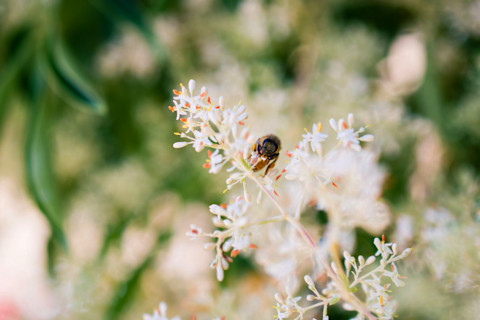This Beauty Swap Is All About Protecting Earth's Biodiversity

The U.N. warned us: We have 12 years before the damage we've done to the Earth becomes irreversible. Instead of letting reports like this paralyze us, let's use them to empower us. The experts are saying it's going to take a mix of large-scale change AND individual action to save our planet—and we want to help you do what you can. Consider our new series your no-excuses guide to cleaning up your act, one step at a time. Today, we've got a tip to help make the world a better place for the bees.
There's a saying that goes, "Tug at a single piece of nature, and you'll find it attached to the rest of the world." And it's true: We don't just share our planet with millions of species; we're all intricately and intrinsically linked.
Honed by millions of years of evolution, Earth's diverse and delicately balanced ecosystems should be thanked for the air we breathe, our food and water, even our medicine. Put it this way: Biodiversity is what makes our planet habitable—and it's shrinking.
The reality is, while climate change is covered eight times more than biodiversity loss1, the two threats to our planet's long-term health go hand in hand. The more we protect biodiversity, the better nature can provide for us and cope with these challenges: We've got coral reefs and mangrove swamps providing coastal protection from cyclones and tsunamis, and trees absorbing air pollution in cities. And we'll need to act quickly to keep this good thing going.
The problem: Species extinction rates are currently 1,000 times higher than ever before in human history.
Our growing human population has harmed natural habitats by deforestation, ocean pollution, global trade, and unsustainable hunting and fishing, to say nothing of our hand in climate change. As a result, species are becoming extinct faster than at any prior time in recorded history, according to some estimates. Once a species becomes extinct, there's no going back, and that's an extremely enormous price considering how much we rely and depend on these ecosystems.
It might sound daunting, but the good news is that we're more aware than ever of our impact and what we can do to help preserve the life of these species, especially when it comes to the pollinators of our plants.

Take the bees: Through the pollination process, they effectively help grow a third of the world's food (from almonds to potatoes to coffee) and around 75 percent of the fruits, nuts, and veggies we eat in the U.S. But over the last two years, bee species have been added to the endangered list for the first time, and you can imagine the repercussions if they're wiped out entirely.
Most of us already know we can help by buying local honey to support beekeepers in our area and shopping for organic produce to ensure we're not playing into the pesticide problem. Short of planting a garden of flowers to attract bees (hands up, city dwellers!), we can also look to our beauty routines for a solution.
The "one small thing" solution: Pick a beauty or skin care product you use daily—and make a nature-friendly swap.
Luckily for us, a good number of beauty brands that make our everyday essentials are actively committing to larger-scale efforts to help reverse damage to our climate and biodiversity, making it easy for us to take part in the solutions.
It's almost too easy when you think about it: One Burt's Bees Lip Balm, for instance, is sold every second. But besides the fact that the tube itself is totally recyclable (and the company has been carbon-neutral certified since 2016), you can feel good about stashing the all-natural balm in your bag, in your office drawer, in your nightstand, and so on. Acting on the brand's pillar of protecting biodiversity, Burt's Bees recently partnered with the E.O. Wilson Biodiversity Foundation to support a huge conservation effort that will map 6,000 species of bees as part of the Half-Earth Project. Doing so will help scientists understand where we should prioritize land care and stewardship so that the bees can continue to thrive.
"Mapping the known species of bees is the first step in their conservation—and ultimately the conservation of much of the flowering plant life and plant-dependent species worldwide," stated E.O. Wilson Biodiversity Foundation president and CEO Paula Ehrlich in a news release. "Burt's Bees' commitment to the mapping of the bees is a critical step toward our goal of conserving the most vital half of the Earth's natural resources for the sake of the planet as a whole."
Another swap worth considering? Look for products that help protect marine life in our oceans, which is essentially a landfill for 8 million tons of plastic each year, affecting nearly 700 species from plankton to whales. Most of this plastic waste won't break down for centuries, so it's floating in our oceans, deteriorating into microplastics that poison marine life and disrupting ecosystems. (Some studies have found that close to 75 percent of fish in certain ecosystems have microplastics in their stomachs.)
Thankfully, more and more brands are supporting the health of our seas not just by donating a percentage of profits to conservational and cleanup projects but also by creating their products (or its packaging) from plastic pulled from the oceans. These efforts aren't simple, but every swap supporting them is a vote with your money to keep it all going.
So whether your beauty essential is a beeswax lip balm, a shampoo in a bottle made from recycled ocean plastic, or serum from a company whose profits help aid reforestation projects, it's never been easier to move toward products that are designed to benefit not just us but our planet and Mother Nature, too. And something as simple as rethinking self-care as Earth-care is the sweet spot of tiny tweaks that support big solutions.
